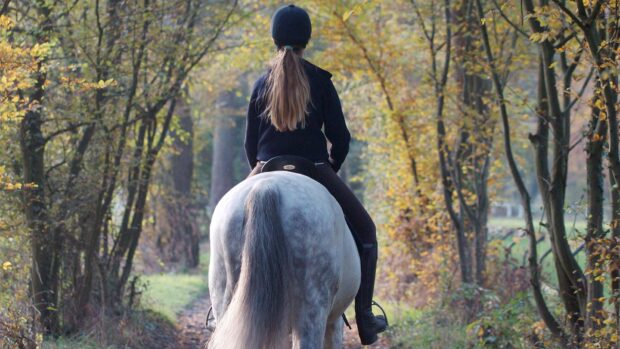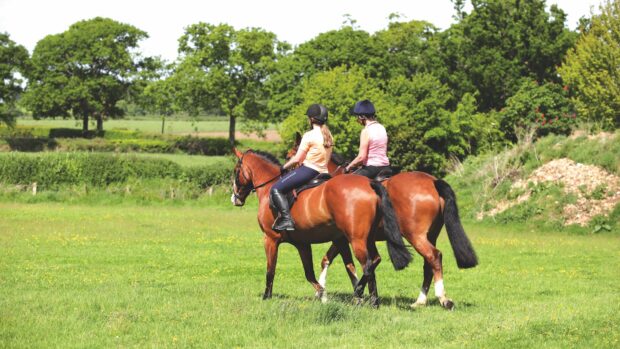Do you struggle to ride your horse behind when hacking with friends? Perhaps your mount is great when he’s leading the way, but becomes hot and buzzy if he’s asked to take a turn in the rear.
Jason Webb, a trainer who specialises in starting young horses and retraining those with problems, says to start training the horse to go behind when hacking in a low energy environment – with just one other horse, in a familiar place.
He suggests three exercises to help with this problem.
1. Alternate positions
“The first thing to do for a little while is to ride in front,” says Jason. “Don’t make a big fuss about it, just allow the horse to be in front and relax.
“Then get the person with you to ride up alongside you. Then I would alternate positions, just checking your horse in behind and coming up to the other side of the other horse and riding along again.
“If your horse gets bothered by this movement, allow him to spend some time in front, before switching again.”
2. Variation within the pace
A problem with your horse going behind when hacking comes down to being able to control your horse’s paces, slowing the horse’s walk and then allowing them to walk on again, says Jason.
“This must be done in an environment that your horse is comfortable with at first and generally I practise this going away from home, with or without company,” he says.
“When I’m on my way home I always find the the most comfortable place for my horse and allow him to be there because a lot of problems with riding in company, and hacking in general, come from holding your horse up when on the way home.
“So on the way out, practise getting your horse to walk slower and then walk out again.”
3. Let the horse choose
You need a companion horse who is happy to stand quietly while another horse walks past in both directions for this exercise.
“Set yourself to go 100m down a track – that’s as far as I want to go because I know when he’s behind my horse gets anxious,” says Jason.
“I start out behind the other horse, then if I feel my horse get anxious, I ask the other person to stop and I’ll allow my horse to go past. When I get in front, I’ll start to ride around in fairly small circles left and right. I’ll do this for a minute maybe, then I’ll ride back past the horse standing patiently waiting for me and position my horse where I want him to be, behind the other horse.
“When I ask him to stand there, he may choose to walk off again to get back in front. If so, all I do is repeat the process of a few circles walking around in front of the other horse and go back. I do this until my horse can stand with a loose rein behind the horse in front.
“The idea of this exercise is that when I’m behind, I don’t hold my horse, I allow him to choose to stay there. If he chooses not to and chooses to go in front, I make it slightly awkward for him by doing some small circles and figures of eight and then I take him back behind and leave him alone again.
“In doing this, I allow my horse to make the decision – if he decides to go in front he has to do these circles and serpentines and it’s quite tight and slightly awkward or he can choose to stay behind where it feels like he’s got space to relax. The horse in front isn’t going anywhere so he will realise maybe this is the best place to be in this situation.”
- To stay up to date with all the breaking news throughout major shows such as London International, plus expert advice on horse care, training, and much more, subscribe to the Horse & Hound website
You might also be interested in:

Be safer on the roads: introduce your horse to traffic with this five-point plan

Want to introduce a horse to a new place without drama? Follow this six-point plan

The Horse & Hound Podcast 55: William Funnell | Riding your horse in company | Bicton review plus news round-up

Why a pat on the neck isn’t what your horse would choose and how to use rewards effectively in training

Subscribe to Horse & Hound magazine today – and enjoy unlimited website access all year round




